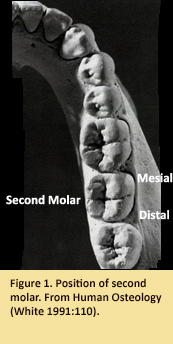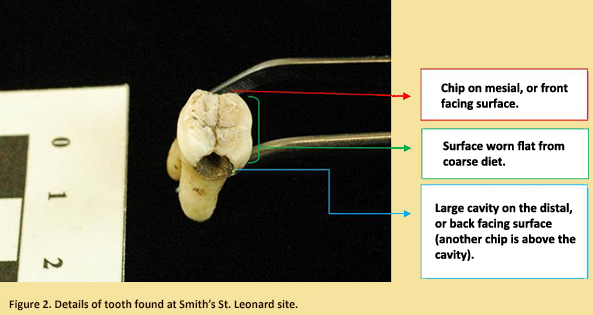Holey Molar!
September 2011
By Annette Cook, MAC Lab Public Archaeology Asst.
 An unusual artifact was recently discovered at Smith's St. Leonard, a tobacco plantation site inhabited by the Smith family from approximately 1711-1754, located on Jefferson Patterson Park and Museum in Calvert County, MD. A single human tooth, the only human remain found on the site thus far, was excavated in the plow zone layer. Plow zone refers to the top layer of soil which has been disturbed due to farming activities. The Smith family cemetery is known, from both historic records and archaeological testing, to be in the area of the Maryland Archaeological Conservation Laboratory, some distance from the site. Therefore, the tooth is not associated with a grave or burial, but was found with normal "trash" associated with the site.
An unusual artifact was recently discovered at Smith's St. Leonard, a tobacco plantation site inhabited by the Smith family from approximately 1711-1754, located on Jefferson Patterson Park and Museum in Calvert County, MD. A single human tooth, the only human remain found on the site thus far, was excavated in the plow zone layer. Plow zone refers to the top layer of soil which has been disturbed due to farming activities. The Smith family cemetery is known, from both historic records and archaeological testing, to be in the area of the Maryland Archaeological Conservation Laboratory, some distance from the site. Therefore, the tooth is not associated with a grave or burial, but was found with normal "trash" associated with the site.
 Teeth are often valuable tools for archaeologists to learn details about a person’s life. While drawing conclusions from study of a single tooth is not possible, its discovery brings up interesting questions about the overall health, dental health, diet and personal hygiene of the people that inhabited Smith’s St. Leonard.
Teeth are often valuable tools for archaeologists to learn details about a person’s life. While drawing conclusions from study of a single tooth is not possible, its discovery brings up interesting questions about the overall health, dental health, diet and personal hygiene of the people that inhabited Smith’s St. Leonard.
Dr. Gary O'Shea of Calvert Dentistry confirmed that the tooth is from the lower right side of the jaw-- a right mandibular molar, probably a second molar. Second molars generally erupt at about age 12 and are the last teeth in the back of the mouth until eruption of the third molars, or wisdom teeth, around age 18.
The tooth has a few distinctive characteristics. Its surface is completely worn flat, with no raised lobes left intact. There is a very large, deep cavity present on the distal surface of the tooth. Two small chips are broken from the tooth on opposite sides, on both the mesial and distal surfaces. Mesial refers to the part of the tooth facing the front of the mouth, while distal refers to the backward facing surface (Figure 2).
Tooth wear can sometimes be an indicator of age in an individual. The coarse diet-- including stone ground corn-- that the inhabitants of the Smith site would have eaten, makes any such determinations difficult, as above-normal wear can be expected. Doctor O'Shea suggests that the large cavity could have been caused, in part, by contact with the neighboring wisdom tooth, and that possibly that wisdom tooth was impacted, creating crowding. If this is true, the individual would have probably been at least 18 years old.

The small chips could very well be marks from the extraction of what was almost certainly a very painful tooth. A "dental key" may have been used for extraction of the tooth, or something as simple as a pair of pliers. The process was probably far from pleasant.
 Dental care in the 18th century was dubious, at best. Formal dentistry did not truly emerge until the mid 19th century (Lewis 1964:268-269). The people at Smith's St. Leonard likely looked to barbers and blacksmiths for removal of damaged or painful teeth. Preventative dental care was minimal. Tooth powders were sprinkled on rags and rubbed on the teeth. While toothbrushes did exist in the 18th century, none have been found on the site. Homemade tooth cleaning mixtures could include ingredients such as vinegar, salt and tobacco ash (Walker 2009:96). The acidic and abrasive qualities of these concoctions probably did as much harm as good, and deep grooves on teeth could result.
Dental care in the 18th century was dubious, at best. Formal dentistry did not truly emerge until the mid 19th century (Lewis 1964:268-269). The people at Smith's St. Leonard likely looked to barbers and blacksmiths for removal of damaged or painful teeth. Preventative dental care was minimal. Tooth powders were sprinkled on rags and rubbed on the teeth. While toothbrushes did exist in the 18th century, none have been found on the site. Homemade tooth cleaning mixtures could include ingredients such as vinegar, salt and tobacco ash (Walker 2009:96). The acidic and abrasive qualities of these concoctions probably did as much harm as good, and deep grooves on teeth could result.
The colonial diet, high in corn (which not only breaks down into sugar, but also sticks to the teeth), caused a high rate of dental caries or cavities (Walker 2009:132). At the nearby 17th century Patuxent Point site in Calvert County, 13 of the individuals from 18 burials had dental cavities. (King and Ubelaker 1996:136-181). Most of those without cavities were children. The most common type of cavity was in the area between the surfaces of two teeth. During colonial times tooth loss, due to periodontal disease, and abscessed teeth were also very common. An abscess would not only be painful, but could pose a serious health risk.
Only if more teeth were located could more information be gathered about the dental health of the people who lived at Smith’s St. Leonard. For reasons of respect no plans exist to excavate in the family cemetery. We know from historical documents that members of the Smith family often died very young. Three family members and 4 enslaved people died in 1748 alone. It is almost certain that poor dental health, as well as disease and accident, affected the quality of life for these colonial people.
| References |
|
| Antique Medical Tools for Dentistry, Health Fiend Online Health Magazine |
|
http://www.healthfiend.com/wp-content/uploads/2011/03/Dental-Tooth-Keys.jpg Picture attributed to
www.phisick.com |
|
| King, Julia A. and Douglas H. Ubelaker |
| 1996 |
Living and Dying on the 17th Century Patuxent Frontier. The Maryland Historical Trust Press, Crownsville, Maryland |
|
| Lewis, Carl P. Jr. |
| 1964 |
The Baltimore College of Dental Surgery and the Birth of Professional Dentistry, 1840. Maryland Historical Magazine 59:3 |
|
| O’Shea, Gary, Calvert Dentistry |
| 2011 |
Personal Communication. |
|
| Walker, Sally M. |
| 2009 |
Written in Bone, Buried Lives of Jamestown and Colonial Maryland. Carolrhoda Books, Minneapolis, Minnesota. |
|
| White, Tim D. |
| 1991 |
Human Osteology. Academic Press, Inc., San Diego, California. |
|